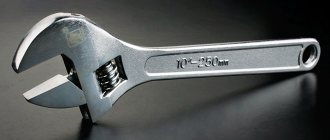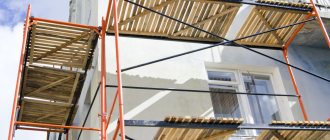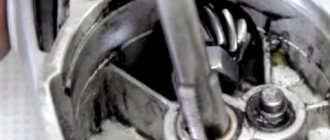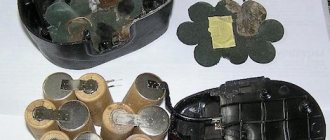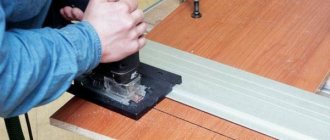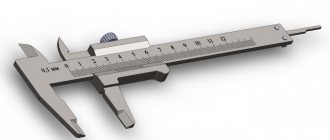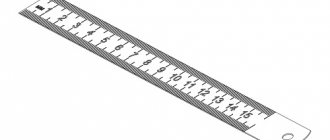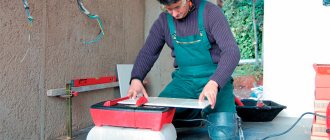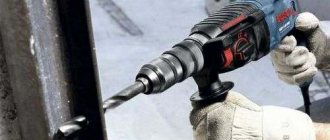Today, specialized departments offer a huge selection of construction tools that greatly facilitate the work process. Some models of devices have an improved design and additional options.
One of these is a plumb line with a cord. What is this tool for and how to use it correctly? The answer to this question is presented in our material.
What is a plumb line and why is it needed?
This is a cylindrical metal weight with a cone at the end. The most common form resembles a large bullet, only the cone is sharp, but other forms are also found. In any case, a thin strong thread or cord is attached to it exactly in the middle. That is why such a tool is called a cord plumb line. That, in fact, is the whole device. There is also a device included that makes it easier to hang it on the wall.
A plumb line is a metal weight with a cord coming out exactly from the middle of it. The shape of the weight is not important, it is important that it has a symmetrical shape and the cord comes out of the middle
With the help of such a simple device, the verticality of walls and structures is checked. If necessary, you can also draw vertical lines on a wall or any other surface: draw vertical lines, then set aside equal distances and connect them to get a vertical line.
The price of such a device is several hundred rubles. The price range is quite wide - there are devices - from the simplest to the more sophisticated, with different sizes and shapes of the load. But you can’t exactly call them expensive.
Design and principle of operation
Using a cord plumb line is simple. The suspended weight guarantees the required gravity force. The cord is stretched, determining the exact vertical direction.
The standard instrument in question includes a body, head, inserts, cord and strips. The first two parts are made of durable steel, inserts are made of polyamide, strips are made of aluminum alloys (thickness no more than 2 mm).
To improve the accuracy of work, sharp edges and burrs are cleaned. For the cord, nylon or chlorine fibers, curled into a kind of small rope, are suitable. As an alternative, analogs are used that have similar characteristics in terms of reliability, strength and elasticity.
How to use
A plumb bob is a device for checking the verticality of surfaces. Therefore, it must be secured at the top point of the plane or object being tested.
Some models are sold with a washer of the same diameter as the cylinder. It turns out that there is a weight at one end and a washer at the other. By applying the washer to the surface and calming the vibrations of the load, you can see if there is a difference between the vertical of the thread and the plane being tested.
By the way, the shadow from the thread is also vertical. So you can navigate by it.
Applying the thread to a vertical surface, wait until its vibrations calm down, and then see if the distance from the surface being tested to the cord is the same.
Other models do not have a washer, but are wound on a piece of plastic, sometimes there are markings on it, like on a ruler. There are plumb lines whose cord is hidden in a plastic case (like a tape measure). Some people find them more convenient to work with, and the body can be used as a support for the cord.
During long-term work (plastering, for example), it is necessary to have a plumb line in front of your eyes and level the surface along it. Then the fastener is most often a long nail or self-tapping screw. It is hammered/screwed in so that it holds tightly, but a significant portion of it sticks out. A cord is tied or wound near the cap, and the weight itself is lowered to the required distance. After the vibrations have stopped, the thread with the weight is an ideal vertical. Having a standard in front of your eyes, you can compare how smooth the surface in front of you is.
In this way you can check the verticality of the wall, the correct placement of household appliances, furniture, etc.
How to “break off corners” using a plumb line is shown in the video. It's difficult to describe, it's better to see. In short, you need to “catch” whether the angle, the plane of the wall and the plumb line coincide or not.
When laying a brick wall, a plumb line with a cord is necessary so that you can check whether the wall has fallen off. To do this, apply it to one side of the wall and the other, checking the distance from the cord to the surface along its entire length. It is clear that the distance should be the same. Such control is carried out at several points. The verticality of walls made of timber and logs is controlled in exactly the same way. But when using non-rounded logs, control is more difficult due to the different diameters of the crowns. However, you can see the deviation in this case too. A plumb line is useful when setting up formwork, installing doors, and constructing a roof truss system. Yes, it is needed in almost any construction and many finishing operations.
The same can be done using a building level. It is much simpler and faster, but this device has a fairly large error. As a result, the walls will move—bend into a hump, or form holes. Therefore, a combination of the two dimensions is desirable. With a little experience, you can check walls with a plumb line through four or five rows of brickwork, using a level the rest of the time.
The cord level has one rather serious drawback: it is almost impossible to work with it in the wind: the weight constantly wobbles, which makes it impossible to fix the position of the cord. In order to somehow combat this scourge, they came up with the idea of immersing the load in a vessel with water. Place a vessel below and recess the plumb cone a little. You can work in moderate winds.
Magnetic plumb line
A magnetic plumb line is the same as a cord plumb line, only it is attached using a magnet.
What upsets builders and installers the most is that they need to fiddle around and somehow secure the cord. The second problem is that the thread often gets tangled, which also does not improve the mood. So they came up with an improved construction plumb line, the thread of which rolls onto a reel located in the body. And to make it more convenient to attach it, several magnets were built into the body. It can be easily installed on any metal surface: a magnet holds it at the desired height.
To make it easy to attach to wood, a needle is made in the same body. So this problem is solved. Due to the presence of magnets in the body, this plumb line received the name “magnetic”. A very convenient and practical thing.
The second version of a homemade plumb line
Bubble type level
Another long-standing and widely used device for checking the inclination of a surface in different planes is a bubble-type building level. It is a piece of perfectly flat, most often aluminum profile with a window in the middle. It contains a capsule filled with a frost-resistant liquid, along which a small air bubble slides. By placing it between the peephole marks, the surface perfectly matches the horizon line.
Along the edges of the slats there are additional windows for measuring inclined and vertical planes, which allows you to use a bubble level instead of a classic plumb line. This is a quick and convenient way to apply markings to a surface, especially in limited height spaces.
Rack levels can be of various lengths, equipped with magnetic holders, and have an electronic system for recording deviations, but the standard for them will remain an air bubble in the liquid inside the measuring device.
How to make a plumb line with your own hands
The key is to find or make a weight that is well centered. Then you need a short bolt of decent diameter (now you’ll understand why). Exactly in the middle of the bolt - through the head, along the rod - drill a hole.
Now a hole is drilled in the body of the load to the size of the bolt and the corresponding thread is cut. A thin, strong cord is threaded into the bolt from the side of the cap. At the exit of the bolt, it is tied into a knot so that it does not jump out. The bolt with the cord is screwed into the prepared hole. That's it, your construction plumb line is made with your own hands.
The second option for attaching the thread is this: make a through hole exactly in the middle of the weight and pass the cord through it, only the loop needs to be made long, and the diameter of the hole should be much larger than the diameter of the cord. All this together will allow the load to take a strictly vertical position.
Laser plumb line
The simplest laser plummet is a laser pointer. Just like that small keychain that children used to play with in their time. Only, since it is a measuring instrument, it must be calibrated.
There are not very many laser devices with only a plumb-line function on the market. There is a very simple model Eubon PB01. This is a metal case on which a laser pointer is mounted on a pin. This device gives only two points - one on the ceiling, the other on the floor. There are no other functions. Levels itself - thanks to the original design, which in general resembles a corded plumb line.
The laser plumb produces a thin luminous beam, which is easy to navigate indoors
This device provides fairly high accuracy - an error of 0.1 mm per meter, operating range - 30 meters, powered by AA batteries. The price for this laser plumb line is the smallest - 3.9 thousand rubles.
The simplest laser plumb line - gives a point on the ceiling exactly above the tip of the cone
Only products from completely unknown companies, which are most likely made in China, can be cheaper. You can find similar devices on trays at prices starting from 600 rubles. But their accuracy needs to be checked, most likely using the same cord plumb line.
There are also laser plummets from more serious companies. But prices here start from 6 thousand rubles. In such models, the laser LED is installed in a plastic case; most of them have a self-leveling system with a deviation from the horizontal of no more than 4°. There are laser plummets from Bosh, DeWOLT, Spectra and some others. Accuracy can vary from 0.2 to 0.4 mm per meter.
You can see how to work with a laser level in the DeWOLT promotional video. Actually there are no difficulties. We placed it in the right place, turned it on, and got points on the ceiling and floor. All.
But there are other devices that, in addition to two points, produce several more rays. At a minimum - vertical and horizontal, as well as their intersection. Experts call such a device a “laser level with a plumb line function.” There is also a name - laser level and plane builder. These are all devices of the same type. Only, maybe with a different number of rays.
It is convenient to use a laser level with a plumb line function for various types of work.
These laser devices cost from 12 thousand rubles, but their scope of use is much wider. There can be from four to six beams, there is a built-in ability to correct deviations up to 4°. The kit often includes a rod and a wall support. This is a useful thing for those who are just starting construction: it can be useful in many jobs. They are used for:
- erection of walls;
- plaster;
- laying tiles;
- when marking holes in the wall, under doors and windows;
- for marking when hanging and displaying furniture and equipment;
- for leveling the screed;
- when working with drywall, it is simply irreplaceable.
The only drawback of laser plummets and levels is that their beam is not visible in sunlight. You can only work outside in cloudy weather. Below, watch a video review from one of the laser level users.
Plumb - simplicity that gives birth to harmony
One of the first measuring devices of this operating principle used by mankind is a plumb line. This simplest device, still in use today, is a rope with a weight at the end. When suspended, the weight pulls on the thread that secures it, forming an ideal vertical guide. Over thousands of years of use, only the shape of the load has changed - from a piece of stone to a spear-shaped tip. And if you attach a laser pointer-keychain to a rope, you will get a simple laser plumb line that perfectly copes with the task of transferring markings from the floor to the ceiling (for example, when installing interior partitions).
The disadvantages of this method include a rather large measurement error associated with too sharp a viewing angle, and the difficulty of securing the load, especially in windy weather.
Electronic plumb line
This is not a tool, but an application that is installed on the iPhone. It's called iHandy Carpenter, that is, “Handed Carpenter.” This is not a measuring device, but it allows you to evaluate how smooth or crooked the finishing is, furniture or appliances are displayed.
How does it work? Launch the application, place the iPhone on the surface to be tested (just not on the side where the power and volume buttons are). There is a weight and a coordinate system on the screen, the deviation is visible visually, and the results are also duplicated at the top of the screen in the “top” projection. Displays the deviation in degrees relative to the normal coordinate system. That's all, actually, with the electronic level for iPhones.
Two applications - electronic plumb lines - for iPhone and Android
There is also a similar program for smartphones and tablets - Plumb-bob. This version of the electronic plumb line for Android makes it possible to measure angles, distances, and also check the vertical and horizontal lines in the image. Having set and measured all the necessary parameters, you can take a photo - all measurement results will remain. You can study them on the screen.
In order for the information about different plumb lines to be complete, we need to talk about the optical plumb line. This is part of a theodolite - a geodetic instrument that there is simply no need to use in everyday life. Unless you worked as a surveyor, but then you can’t have any questions.
